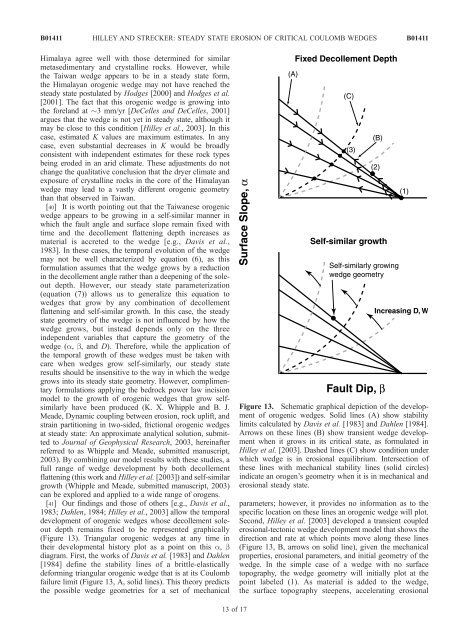Steady state erosion of critical Coulomb wedges with applications to ...
Steady state erosion of critical Coulomb wedges with applications to ...
Steady state erosion of critical Coulomb wedges with applications to ...
You also want an ePaper? Increase the reach of your titles
YUMPU automatically turns print PDFs into web optimized ePapers that Google loves.
B01411 HILLEY AND STRECKER: STEADY STATE EROSION OF CRITICAL COULOMB WEDGES<br />
Himalaya agree well <strong>with</strong> those determined for similar<br />
metasedimentary and crystalline rocks. However, while<br />
the Taiwan wedge appears <strong>to</strong> be in a steady <strong>state</strong> form,<br />
the Himalayan orogenic wedge may not have reached the<br />
steady <strong>state</strong> postulated by Hodges [2000] and Hodges et al.<br />
[2001]. The fact that this orogenic wedge is growing in<strong>to</strong><br />
the foreland at 3 mm/yr [DeCelles and DeCelles, 2001]<br />
argues that the wedge is not yet in steady <strong>state</strong>, although it<br />
may be close <strong>to</strong> this condition [Hilley et al., 2003]. In this<br />
case, estimated K values are maximum estimates. In any<br />
case, even substantial decreases in K would be broadly<br />
consistent <strong>with</strong> independent estimates for these rock types<br />
being eroded in an arid climate. These adjustments do not<br />
change the qualitative conclusion that the dryer climate and<br />
exposure <strong>of</strong> crystalline rocks in the core <strong>of</strong> the Himalayan<br />
wedge may lead <strong>to</strong> a vastly different orogenic geometry<br />
than that observed in Taiwan.<br />
[40] It is worth pointing out that the Taiwanese orogenic<br />
wedge appears <strong>to</strong> be growing in a self-similar manner in<br />
which the fault angle and surface slope remain fixed <strong>with</strong><br />
time and the decollement flattening depth increases as<br />
material is accreted <strong>to</strong> the wedge [e.g., Davis et al.,<br />
1983]. In these cases, the temporal evolution <strong>of</strong> the wedge<br />
may not be well characterized by equation (6), as this<br />
formulation assumes that the wedge grows by a reduction<br />
in the decollement angle rather than a deepening <strong>of</strong> the soleout<br />
depth. However, our steady <strong>state</strong> parameterization<br />
(equation (7)) allows us <strong>to</strong> generalize this equation <strong>to</strong><br />
<strong>wedges</strong> that grow by any combination <strong>of</strong> decollement<br />
flattening and self-similar growth. In this case, the steady<br />
<strong>state</strong> geometry <strong>of</strong> the wedge is not influenced by how the<br />
wedge grows, but instead depends only on the three<br />
independent variables that capture the geometry <strong>of</strong> the<br />
wedge (a, b, and D). Therefore, while the application <strong>of</strong><br />
the temporal growth <strong>of</strong> these <strong>wedges</strong> must be taken <strong>with</strong><br />
care when <strong>wedges</strong> grow self-similarly, our steady <strong>state</strong><br />
results should be insensitive <strong>to</strong> the way in which the wedge<br />
grows in<strong>to</strong> its steady <strong>state</strong> geometry. However, complimentary<br />
formulations applying the bedrock power law incision<br />
model <strong>to</strong> the growth <strong>of</strong> orogenic <strong>wedges</strong> that grow selfsimilarly<br />
have been produced (K. X. Whipple and B. J.<br />
Meade, Dynamic coupling between <strong>erosion</strong>, rock uplift, and<br />
strain partitioning in two-sided, frictional orogenic <strong>wedges</strong><br />
at steady <strong>state</strong>: An approximate analytical solution, submitted<br />
<strong>to</strong> Journal <strong>of</strong> Geophysical Research, 2003, hereinafter<br />
referred <strong>to</strong> as Whipple and Meade, submitted manuscript,<br />
2003). By combining our model results <strong>with</strong> these studies, a<br />
full range <strong>of</strong> wedge development by both decollement<br />
flattening (this work and Hilley et al. [2003]) and self-similar<br />
growth (Whipple and Meade, submitted manuscript, 2003)<br />
can be explored and applied <strong>to</strong> a wide range <strong>of</strong> orogens.<br />
[41] Our findings and those <strong>of</strong> others [e.g., Davis et al.,<br />
1983; Dahlen, 1984; Hilley et al., 2003] allow the temporal<br />
development <strong>of</strong> orogenic <strong>wedges</strong> whose decollement soleout<br />
depth remains fixed <strong>to</strong> be represented graphically<br />
(Figure 13). Triangular orogenic <strong>wedges</strong> at any time in<br />
their developmental his<strong>to</strong>ry plot as a point on this a, b<br />
diagram. First, the works <strong>of</strong> Davis et al. [1983] and Dahlen<br />
[1984] define the stability lines <strong>of</strong> a brittle-elastically<br />
deforming triangular orogenic wedge that is at its <strong>Coulomb</strong><br />
failure limit (Figure 13, A, solid lines). This theory predicts<br />
the possible wedge geometries for a set <strong>of</strong> mechanical<br />
13 <strong>of</strong> 17<br />
B01411<br />
Figure 13. Schematic graphical depiction <strong>of</strong> the development<br />
<strong>of</strong> orogenic <strong>wedges</strong>. Solid lines (A) show stability<br />
limits calculated by Davis et al. [1983] and Dahlen [1984].<br />
Arrows on these lines (B) show transient wedge development<br />
when it grows in its <strong>critical</strong> <strong>state</strong>, as formulated in<br />
Hilley et al. [2003]. Dashed lines (C) show condition under<br />
which wedge is in <strong>erosion</strong>al equilibrium. Intersection <strong>of</strong><br />
these lines <strong>with</strong> mechanical stability lines (solid circles)<br />
indicate an orogen’s geometry when it is in mechanical and<br />
<strong>erosion</strong>al steady <strong>state</strong>.<br />
parameters; however, it provides no information as <strong>to</strong> the<br />
specific location on these lines an orogenic wedge will plot.<br />
Second, Hilley et al. [2003] developed a transient coupled<br />
<strong>erosion</strong>al-tec<strong>to</strong>nic wedge development model that shows the<br />
direction and rate at which points move along these lines<br />
(Figure 13, B, arrows on solid line), given the mechanical<br />
properties, <strong>erosion</strong>al parameters, and initial geometry <strong>of</strong> the<br />
wedge. In the simple case <strong>of</strong> a wedge <strong>with</strong> no surface<br />
<strong>to</strong>pography, the wedge geometry will initially plot at the<br />
point labeled (1). As material is added <strong>to</strong> the wedge,<br />
the surface <strong>to</strong>pography steepens, accelerating <strong>erosion</strong>al
















